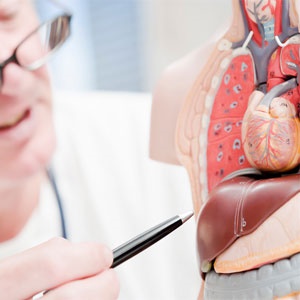
There are many causes of liver disease: some are congenital (i.e. present at birth) or hereditary, while others are acquired, secondary to a variety of causes. These causes include infections, exposure to certain drugs and toxins, and other metabolic issues.
The average liver is a large organ (the second largest in the body, after the skin) that weighs about 1.5kg. The liver is situated in the upper right-hand side of the abdomen and is protected in part by the rib cage.
It performs an innumerable amount of major functions in the body and plays a role in metabolism, immunity, digestion and the storage of nutrients.
The liver secretes bile, which is stored in the gall bladder. After meals, bile is released into the small bowel to help with the digestion of fats and the absorption of certain vitamins. The liver receives blood directly from the whole gut and processes these nutrients so that the body can use them.
Some of the main functions of the liver include:
- Regulating the production of proteins
- Maintaining blood volume
- Regulating blood clotting
- Bile production
- Storing iron
- Breaking down toxins and releasing them from the body
- Removing bacteria from the blood and assisting the immune system
- Making and storing cholesterol and fatty acids
- Storing sugar as glycogen, producing sugar when its needed, and making it possible for the body to use sugar as energy
The liver is, within reason, able to regenerate itself when injured or damaged.
However, if the damage is overwhelming or chronic, progressive declining function occurs and a liver transplant may become necessary. You simply cannot live without a functioning liver, and no effective machine currently exists to take over its function.
Although the different types of liver disease each have their own set of symptoms, some common features include jaundice (a yellowing of the skin and the whites of the eyes), weakness and fatigue, weight loss, nausea, diarrhoea, and abdominal pain.
For more information about how the liver works, and why it’s such an important organ, have a look at this video.
Course and prognosis of liver disease
The treatment and prognosis of liver disease depends on the type of disease you have.
Certain infectious liver diseases have a high recovery rate, but once liver scarring has taken place, the damage is usually irreversible.
Note that cirrhosis, liver cancer and liver failure are serious, life-threatening conditions that should be managed with the help of an experienced medical team. If you have cirrhosis, you have an increased risk for infections and liver cancer, and treatment may involve a liver transplant.
It’s important to catch liver disease early, before permanent damage occurs, and to treat the cause. If the disease is alcohol related, it’s never too late to stop drinking. If you have non-alcoholic fatty liver disease, the most common liver disease worldwide, it’s important to lose weight and exercise.
In South Africa, deaths due to liver disease are poorly characterised. See how South Africa’s death rates compare to the rest of the world
Read more:
Symptoms of liver disease
Reviewed by Dr Mark Sonderup, B Pharm, MB ChB, FCP (SA). Senior Specialist, Division of Hepatology, Department of Medicine, University of Cape Town and Groote Schuur Hospital. March 2018.




 Publications
Publications
 Partners
Partners















